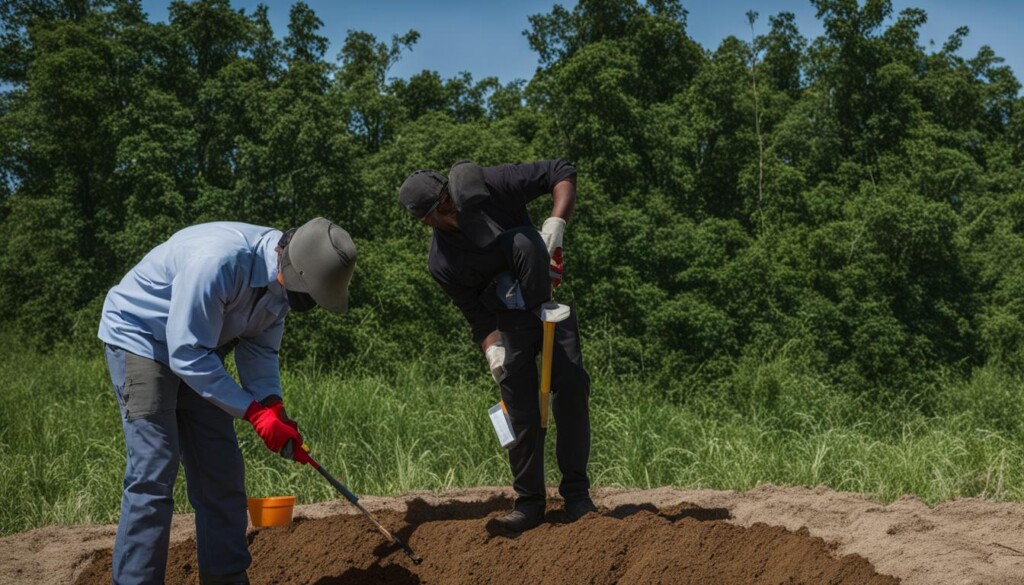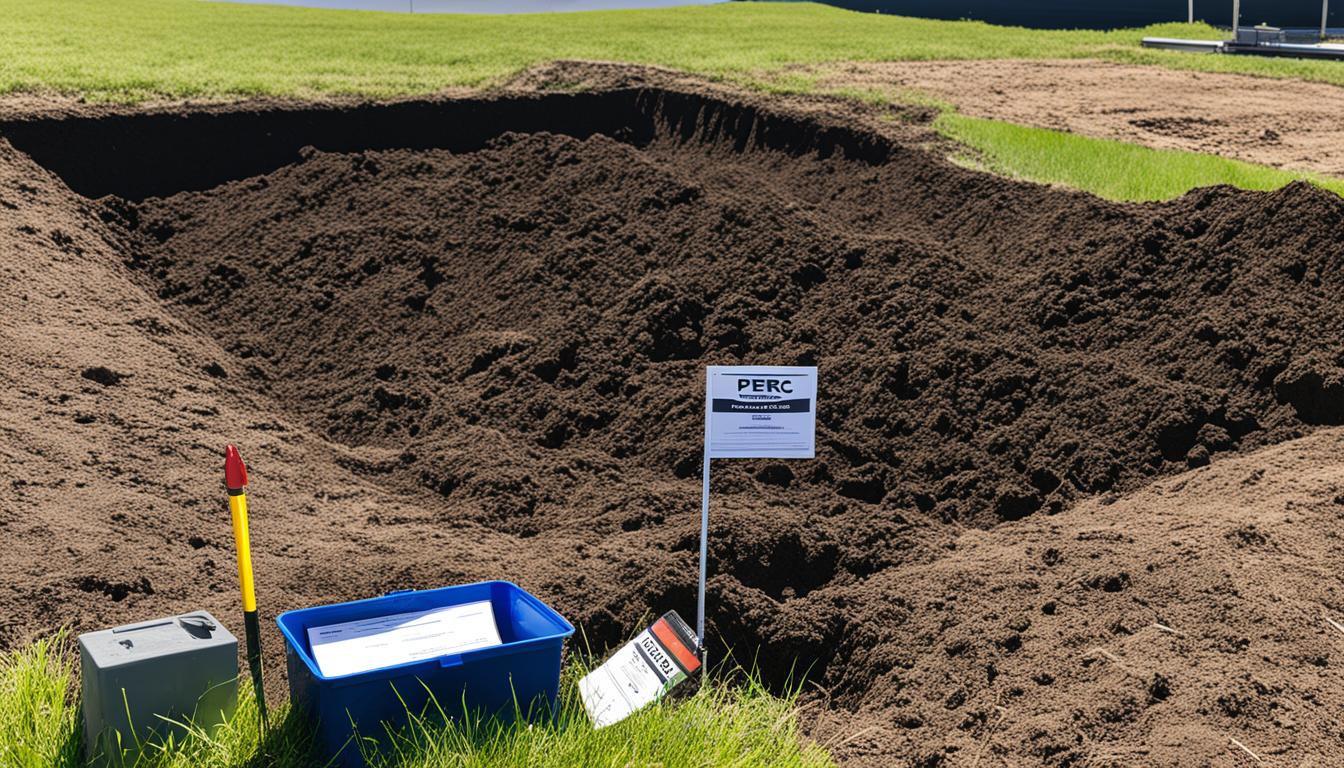Content Team
May 7, 2024
In this comprehensive guide, we will walk you through the process of getting a Perc Test on vacant land. We will cover everything from understanding the perc test requirements and costs to conducting the test and obtaining approval for your septic system installation. By following these steps, you can ensure the safe and proper use of your land.
Key Takeaways:
- Understanding the perc test requirements is essential before conducting the test.
- Hiring a qualified perc test professional ensures accurate results and compliance with local regulations.
- The perc test involves measuring the rate at which water drains through the soil to determine its suitability for a septic system.
- Interpreting the perc test results helps make informed decisions regarding septic system installation.
- Perc test approval is necessary before proceeding with septic system installation, ensuring compliance with local regulations.
What is a Perc Test?
Before diving into the details, it’s important to understand what a Perc Test is. A Perc Test, short for Percolation Test, is a soil analysis conducted to determine the rate at which water drains through the soil. This test helps evaluate whether the soil is suitable for installing a septic system by measuring its ability to absorb water.
Perc Test Requirements
Before starting the perc test, it is essential to understand and meet the requirements set by your local health department or regulatory agency. These requirements ensure that the test is conducted properly and in compliance with the necessary guidelines. Failure to adhere to these requirements can result in inaccurate results or even delays in the approval process.
Here are some common perc test requirements that you should be aware of:
- Minimum number of test holes: The regulatory agency may specify the minimum number of test holes that need to be dug on your property. This requirement ensures that the perc test provides representative results for the entire area where the septic system will be installed.
- Depth of holes: The depth at which the test holes should be dug may also be a requirement. The regulatory agency may specify a minimum depth to ensure accurate measurements of the soil’s ability to absorb water.
- Testing season: In some areas, there may be specific seasons during which perc tests can be conducted. This requirement takes into account factors such as ground conditions and water table levels, which can affect the accuracy of the test results.
It is important to check with the appropriate authorities to fully understand and meet these perc test requirements. Doing so will help ensure that your test is carried out correctly and increase the chances of obtaining accurate results.
Note: The specific perc test requirements may vary depending on your location and local regulations. It is always best to consult with your local health department or regulatory agency to get the most accurate and up-to-date information.
Now that you understand the perc test requirements, let’s move on to the next section where we will discuss the importance of hiring a qualified perc test professional.
Common Perc Test Requirements
| Requirement | Description |
|---|---|
| Minimum number of test holes | The minimum number of test holes that need to be dug on the property |
| Depth of holes | The specified depth at which the test holes should be dug |
| Testing season | The specific season during which perc tests can be conducted |
Hiring a Perc Test Professional
While conducting a perc test yourself may seem like a cost-saving option, hiring a qualified perc test professional is highly advisable. These experts possess the necessary expertise and equipment to accurately perform the test and interpret the results. Additionally, they ensure that the test is conducted in compliance with local regulations, giving you peace of mind throughout the process.
By entrusting your perc test to a professional, you can benefit from their knowledge and experience in navigating the intricacies of the perc test process. They understand the intricacies of soil analysis and can provide valuable insights into the suitability of your land for septic system installation.
Qualified perc test professionals are well-versed in identifying potential challenges and addressing them effectively. Their ability to assess different soil conditions and interpret the data accurately simplifies the decision-making process for you. With their guidance, you can make informed choices regarding the size and capacity of your septic system, ensuring its optimal performance.
Moreover, working with a perc test professional ensures that your test results are reliable and credible. When it comes to compliance and obtaining necessary approvals, having accurate test data can expedite the process and minimize delays.
Benefits of Hiring a Perc Test Professional:
- Expertise in conducting a perc test and interpreting results accurately
- Compliance with local regulations throughout the test process
- Insights into soil suitability for septic system installation
- Identification and resolution of potential challenges
- Informed decision-making for septic system size and capacity
- Reliable and credible test results
“Hiring a qualified perc test professional not only simplifies the testing process but also ensures accurate results and compliance with local regulations.”
When it comes to conducting a perc test and embarking on a septic system installation, it’s essential to prioritize accuracy, compliance, and expertise. With a qualified perc test professional by your side, you can navigate the perc test process seamlessly, ensuring the suitability of your land and the safety of your future septic system.

Conducting the Perc Test
Once you have familiarized yourself with the perc test requirements and hired a qualified professional, it’s time to conduct the perc test on your vacant land. The perc test is a crucial step in determining the suitability of your soil for a septic system installation.
To conduct the test, your perc test professional will follow a series of steps:
- Step 1: Digging Test Holes: Test holes are dug at multiple locations on your property, typically in the area where you plan to install the septic system. These holes should be evenly spaced to ensure representative results.
- Step 2: Filling with Water: Each test hole is then filled with water, allowing it to soak into the soil. The water level should be maintained consistently throughout the test.
- Step 3: Measuring the Drainage Rate: The rate at which the water drains from each test hole is measured and recorded. This is usually done by observing the time it takes for the water level to drop by a specific amount, such as one inch.
- Step 4: Repeating the Test: The perc test is typically conducted at multiple test holes to ensure accurate and consistent results. This provides a comprehensive understanding of the soil’s ability to absorb water.
It is important to follow all the necessary steps and guidelines provided by your perc test professional to ensure accurate results. This will help determine whether your land can support a septic system and guide you in making informed decisions for your property.
Now that you understand how the perc test is conducted, we can move on to the next section, where we will explore the interpretation of perc test results and the importance of obtaining perc test approval.
Interpreting the Perc Test Results
Once the perc test is completed, the results will provide crucial insights into the soil’s suitability for a septic system installation. The results of the perc test will primarily revolve around the perc rate, which is the rate at which the soil absorbs water and is measured in minutes per inch.
The perc rate plays a significant role in determining the size and capacity of the septic system that can be installed on the property. Higher perc rates indicate better drainage capacity, allowing for a larger septic system, while lower perc rates may restrict the size and functioning of the system.
To effectively interpret the perc test results, it’s essential to understand the achievable perc rates and their implications:
- A perc rate of less than 5 minutes per inch suggests poor drainage capacity, indicating that the soil may not be suitable for a conventional septic system. Alternative wastewater treatment options may need to be explored.
- A perc rate between 5 and 60 minutes per inch indicates adequate drainage capacity for a conventional septic system. The system’s size and design will be determined based on the specific rate within this range.
- If the perc rate exceeds 60 minutes per inch, it signifies excellent drainage capacity. This enables the installation of larger septic systems without restrictions.
Understanding the significance of the perc rate will empower you to make informed decisions about the septic system installation. It will also help you communicate effectively with professionals during the approval process.
Obtaining Perc Test Approval
To move forward with the installation of your septic system, you will need to obtain perc test approval from the local health department or regulatory agency. This approval confirms that your soil meets the necessary requirements for a septic system installation. The process may involve submitting the perc test results and any required documentation.
Perc Test Costs
The cost of conducting a perc test can vary depending on several factors including location, soil condition, and the number of test holes required. It is important to budget for these costs in order to properly plan for your project. Here are the main cost considerations to keep in mind:
- Professional Fees: Hiring a qualified perc test professional is highly recommended to ensure accurate results and compliance with local regulations. The professional fees for conducting a perc test can range from $500 to $2,000 or more, depending on the complexity of the test and the location.
- Equipment Rental: If you choose to conduct the perc test yourself, you may need to rent or purchase specialized equipment such as a perc testing apparatus and soil sample containers. The rental costs for this equipment typically range from $50 to $200 per day.
- Permit Fees: Some local jurisdictions require permits for conducting a perc test. These permit fees can vary widely, ranging from $50 to $500 or more, depending on your location and the specific requirements of your area.
It is always a good idea to get an estimate from a perc test professional before proceeding with the test. They will be able to provide you with a more accurate cost breakdown based on the specific details of your project.
As with any construction or land development project, it is important to factor in the cost of conducting a perc test into your overall budget. By understanding and planning for these costs, you can ensure that the necessary funds are available and that there are no surprises along the way.
The Importance of a Perc Test
When it comes to any construction or land use that requires a septic system, conducting a perc test is of utmost importance. This test ensures that the soil on your property has the ability to adequately absorb and treat wastewater, preventing potential health hazards and environmental contamination.
A proper perc test helps protect not only the property owner but also the surrounding community. By confirming the soil’s ability to handle waste, it ensures that the septic system will function effectively and efficiently, minimizing the risk of system failures and costly repairs in the future.
“A perc test provides valuable insights into the quality of the soil and its suitability for a septic system installation. It is a crucial step in ensuring the safety and longevity of the system.”
Moreover, a perc test is especially significant for new construction projects. The test results guide the design and sizing of the septic system, ensuring that it can adequately meet the property’s wastewater needs. By conducting a perc test before construction begins, you can avoid potential setbacks and ensure compliance with local regulations.
Ultimately, investing in a perc test upfront saves you from potential headaches and costly surprises in the long run. It allows you to make informed decisions about your property and ensures that your septic system functions optimally, protecting both your investment and the environment.

Key Takeaways:
- A perc test assesses the ability of the soil to absorb and treat wastewater.
- It helps prevent health hazards and environmental contamination.
- Perc tests are crucial for new construction projects to ensure proper system sizing and compliance.
- Investing in a perc test upfront saves you from potential problems and costly repairs in the future.
Conclusion
Getting a Perc Test on your vacant land is a crucial step to ensure the safe installation of a septic system and proper land use. By carefully adhering to the guidelines and requirements, and collaborating with qualified professionals, you can guarantee that your septic system will operate effectively and meet all necessary regulations. It’s important to remember that conducting a perc test is not just a legal requirement; it’s an investment in the long-term health and sustainability of your property.
By conducting a perc test, you can determine whether the soil on your land is capable of absorbing and treating wastewater adequately. This helps prevent potential health hazards and environmental contamination. A septic system that functions properly also safeguards the well-being of both property owners and the surrounding community.
When it comes to perc tests, it’s best to rely on professionals who have the expertise and equipment to conduct accurate tests and interpret the results. They will ensure that the test is carried out in compliance with local regulations, increasing your chances of obtaining approval for your septic system installation.
FAQ
How do I get a Perc Test on vacant land?
What is the process of conducting a Perc Test?
What are the requirements for a Perc Test?
Should I hire a Perc Test professional?
How do I interpret the Perc Test results?
How do I obtain Perc Test approval?
How much does a Perc Test cost?
Why is a Perc Test important?
Recent Blogs
Perc Test Guide for Vacant Landowners
In this comprehensive guide, we will walk you through the process of getting a Perc Test on vacant land. We will cover everything from understanding the perc
Rural Land Purchase Guide: What to Know
Are you considering buying land in rural areas? Whether you're looking for a peaceful countryside retreat, an investment opportunity, or a chance to embrace a self-sufficient lifestyle,
The Joys of Living In Rural Areas: Serene Bliss
Living in rural areas offers a unique and enchanting experience that is unparalleled. The serene bliss of countryside living provides a break from the hustle and bustle
Land Investment: Value Increase Over Time Explained
Welcome to our guide on investing in land and understanding the potential value increase over time. Land can be a lucrative investment opportunity, offering enticing returns and
Benefits of Home Gardening: Why It’s Vital
Welcome to our article on the benefits of home gardening. In today's fast-paced world, where convenience often takes precedence, the act of nurturing and growing plants in
Living in the Appalachians: Insights & Lifestyle
Welcome to the breathtaking region of the Appalachians, where the beauty of the mountains and the warmth of its communities create a unique and enriching living experience.
Why More Americans Choose Rural Life in 2024
Over the past decade, there has been a noticeable trend of Americans moving away from crowded cities and embracing the quiet, serene lifestyle of rural areas. In
Investing in Rural Land: Essential Tips
Are you considering investing in rural land? Whether you're looking for a peaceful getaway or an opportunity to diversify your investment portfolio, rural land can offer unique
Comparing Affordability: Rural Living vs. City Living
When it comes to choosing a place to live, affordability is often a top consideration. Rural areas can offer a less expensive lifestyle compared to bustling cities,










